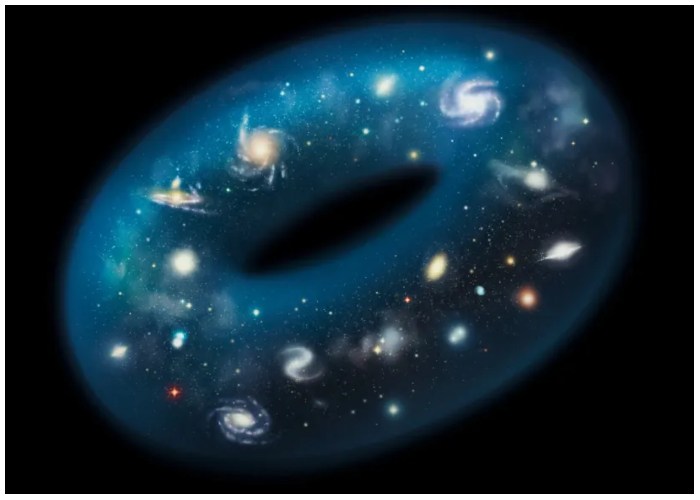The universe might have more in common with a doughnut than we ever imagined. Doughnuts, known for their delicious taste, also have a distinctive shape, or topology, in mathematical terms. This complex topology could be a clue to understanding the shape of our universe. Physicists, in a study published in the April 26 issue of Physical Review Letters, explore the possibility that our cosmos might have a similar intricate structure. This could mean that traveling across the universe might eventually bring you back to your starting point, a concept that has yet to be disproven.
Trivial vs. Nontrivial Topology
In topology, a surface with trivial topology allows any closed loop to be shrunk to a point. For example, traveling around Earth’s equator forms a closed loop, but you can “squish” this loop by moving it to the North Pole. In contrast, a doughnut’s surface, with its hole, represents nontrivial topology. A loop around the hole cannot be reduced to a point due to the hole’s presence. Currently, the universe is believed to have a trivial topology, but this isn’t certain. Cosmologist Dragan Huterer of the University of Michigan finds the idea of a universe with nontrivial topology fascinating and believes we might be able to measure it.
The Pac-Man Analogy
A universe with nontrivial topology could resemble the classic arcade game Pac-Man. In the game, moving off one edge of the screen brings you back on the opposite side. Similarly, in a nontrivial topological universe, traveling far enough in one direction might return you to your starting point. Scientists have searched for evidence of such a topology in the cosmic microwave background, the light from when the universe was 380,000 years old. They looked for identical circles in different sky regions and subtle correlations between different spots. These searches haven’t found evidence yet, but researchers argue that previous studies only considered a small subset of possible topologies.

New Topological Possibilities
The recent study by theoretical physicist Glenn Starkman and his colleagues introduces 17 possible nontrivial topologies for the cosmos. One previously considered topology is the 3-torus, a cube-like shape that loops back on itself, much like the Pac-Man screen. Exiting any side of this cube would bring you back to the opposite side. Although searches for a simple 3-torus have been unsuccessful, variations of the 3-torus, where the sides of the cube are twisted relative to each other, haven’t been fully explored. For instance, exiting the top of the cube might bring you back to the bottom, but rotated 180 degrees.
Future Searches and Implications
The new study evaluates how these different topologies might leave signatures in the cosmic microwave background. Future analyses of this ancient light could reveal hints of these complex structures. However, searching for these topologies will be computationally challenging, likely requiring advanced machine learning techniques to speed up calculations. Researchers also plan to look for signs of nontrivial topology in upcoming galaxy distribution surveys, such as data from the European Space Agency’s Euclid space telescope.
There is a strong motivation to search for nontrivial topology. Starkman points out that some features of the cosmic microwave background suggest the universe isn’t uniform in all directions, a potential sign of nontrivial topology. This asymmetry remains one of the biggest mysteries in cosmology. If the universe does indeed share its topology with a doughnut, it could provide answers to some of the most fundamental questions about the structure of our cosmos.